January 2019
Phnom Penh
In Thailand I met another Swiss colleague, with whom I flew to Phnom Penh, the capital of Cambodia. I have visited this country several times. The first time was in 1991, when the Vietnamese occupation just ended, then again in 2004 and finally in 2011. It is interesting to see how this country is developing.
In Phnom Penh there are now a few skyscrapers and small shopping centers, traffic has increased and the streets in the city are all paved. Nevertheless, it is still a very traditional Asian city, as you can’t find it in other, more developed countries of Asia. Here there are still bicycle rickshaws, on which a person transports passengers and goods with its muscle power. The markets and their offer remained unchanged and all kinds of services are offered on the streets, such as hair cutting.
There is no need for a hairdresser’s studio to have your hair cut.

On the banks of the Tonle Sap River a few huge hotels have been built in recent years.

Wat Phnom Temple
The Wat Phnom Temple, an oasis of peace in the middle of Phnom Penh, was our first destination. In the past there was an elephant on the temple grounds. Early in the morning and in the evening she walked along the river from and to her sleeping place. I learned that in 2012, an animal welfare organization had spent USD 45,000 for two years on medical care and a species-appropriate keeping of the elephant lady Sambo. That’s a lot of money in a country where most people have to live on a few dollars a day. Upon completing this project, the owner threatened to return Sambo to the temple to support the elephant. The ‘The Elephant Valley Project’ animal welfare project stepped in and compensated the owner for the lost profit, so that Sambo can now live species-appropriate in a forest area.
Wat Phnom Temple is one of the most interesting temples in Phnom Penh. In the foreground is the goddess of the earth Nān Ganhān, who wrings water out of her hair. The flood generated in this way washed away Mara, the goddess of evil, protecting Buddha on his way to enlightenment.

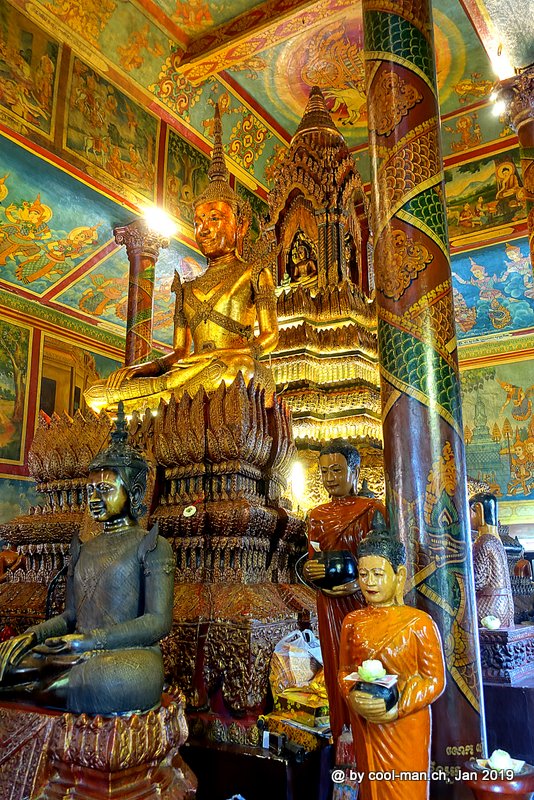
Wat Ounalom
Our way from the hotel to the river led us through the temple district of Wat Ounalom, founded in 1443, which is located in the immediate vicinity of the Royal Palace. As the seat of the Cambodian Mohanikay Order, it is the most important temple of Phnom Penh and the center of Cambodian Buddhism.
An exit of the temple district of Wat Ounalom
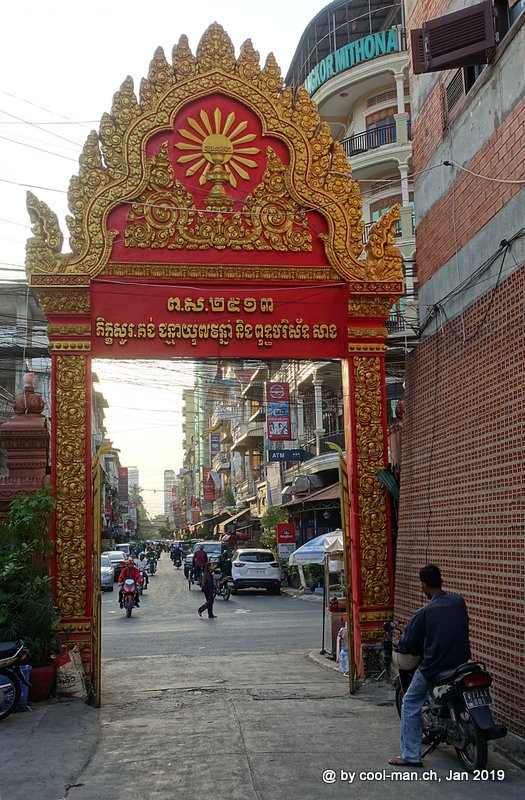

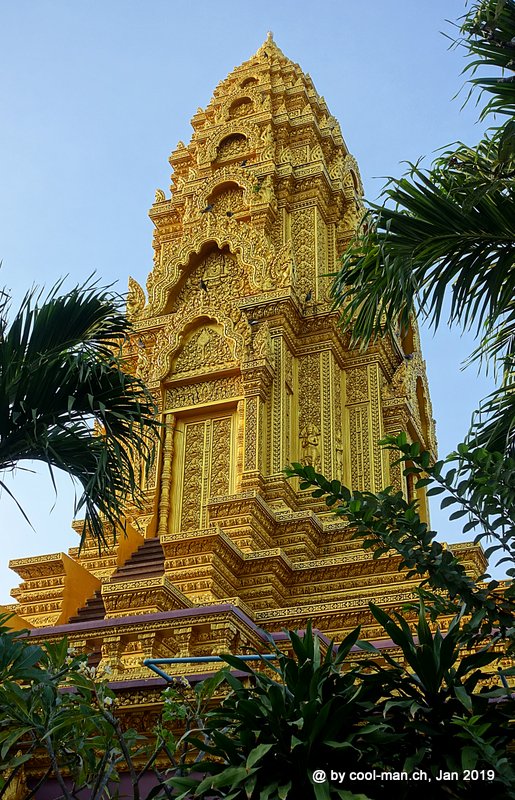
A historical ox cart used for ceremonial purposes.
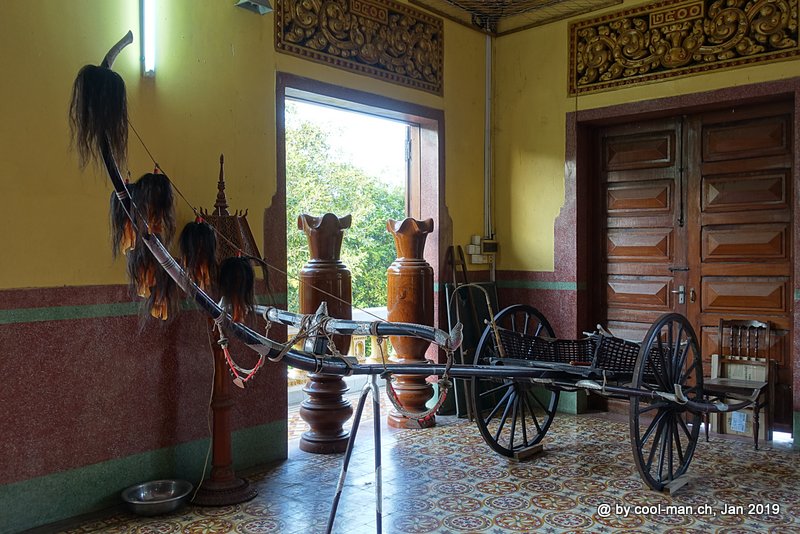
As on my previous trips I noticed the many good European restaurants in the country. Especially the French enrich the gastronomic scene. Perhaps because Cambodia was a French protectorate from 1867 until independence in 1953. We usually had breakfast at the ‘Daughters of Cambodia’. The cafe is run by a NGO that uses the proceeds from the cafe and donations to fight human trafficking and help women to free themselves from the sex industry.
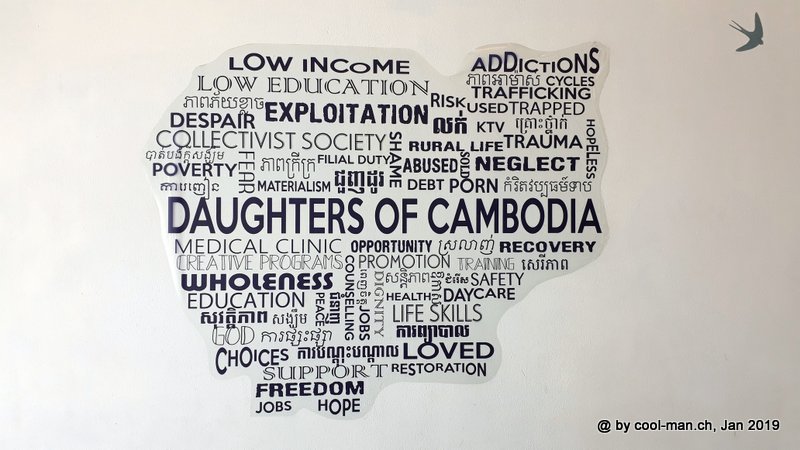
Kampot
Already after a few days the hectic pace in Phnom Penh became too much for us and we traveled 155 km to the coast to the town of Kampot. This city also has a busy center, but life takes its leisurely course along the river. Also here there were some good restaurants run by Europeans. One of our favourites was the Italian restaurant ‘Armando’, which had an excellent tiramisu on its menu next to pizzas, grappa and limoncello. We also liked to visit the ‘Auberge de Soleil’ of the French Swiss Cédric, where even fondue was available (which I didn’t order, though, as in my opinion it was too hot for that), but there was also a Zurich Geschnetzeltes (Zurich-style veal stew) on the menu. At ‘Simple Things’ we often had breakfast, because the excellent Cafe Latte and the fresh Muesli made a good start into the new day.
The ‘Auberge de Soleil’ of the French Swiss Cédric, which mainly offers Swiss specialties

Pepper plantation
What makes Kampot special is the pepper, which is considered one of the best in the world and which has been awarded the internationally protected designation of origin “Kampot Pepper PGI” (protected geographical indication). The heavy, mineral loam soils and the climate provide excellent conditions for the cultivation of this crop.
We visited the plantation of a Frenchwoman and a Belgian, who have been cultivating organic pepper here since 2013 and whose project provides work and a school for people in the nearby villages. The tour provided interesting facts about pepper.
These bicycle carriages were just exhibits on the plantation.
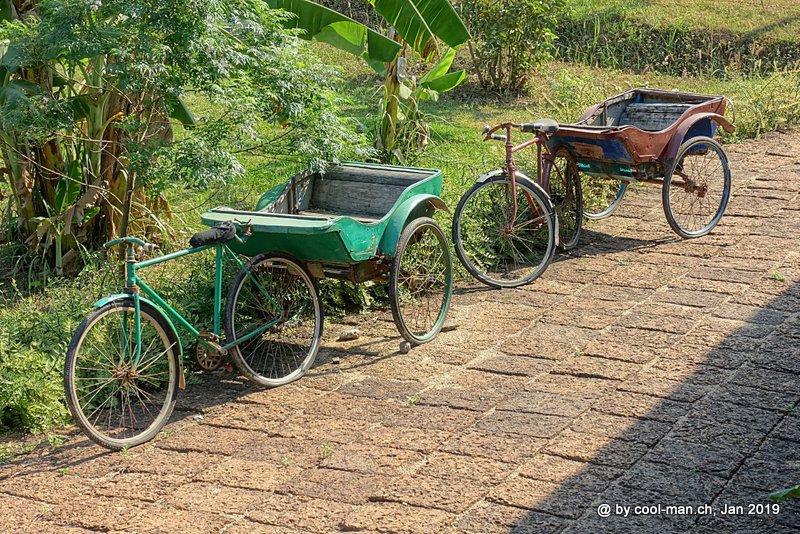
Pepper is made from the fruits of the pepper bush. The pepper plant is a climbing plant that can grow up to 10 meters high on trees. In plantations, the plant is usually kept at 3 to 4 meters.
The pepper plant is a climbing plant.
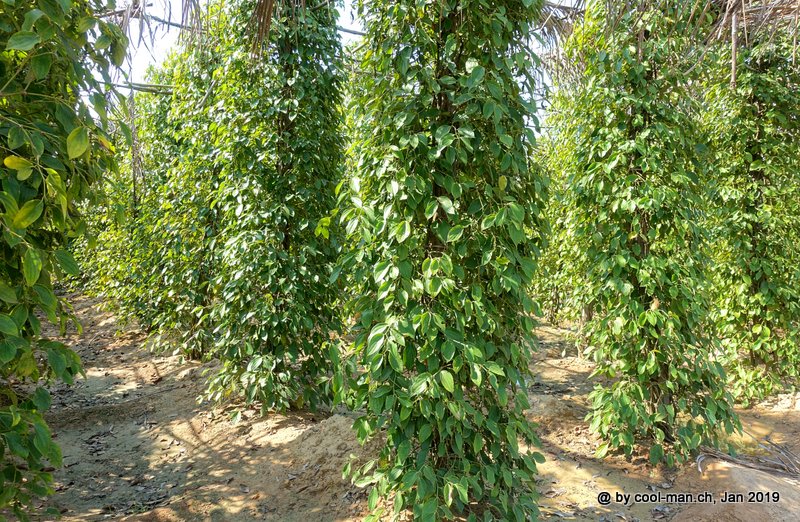
Those peppercorns are not ripe yet.
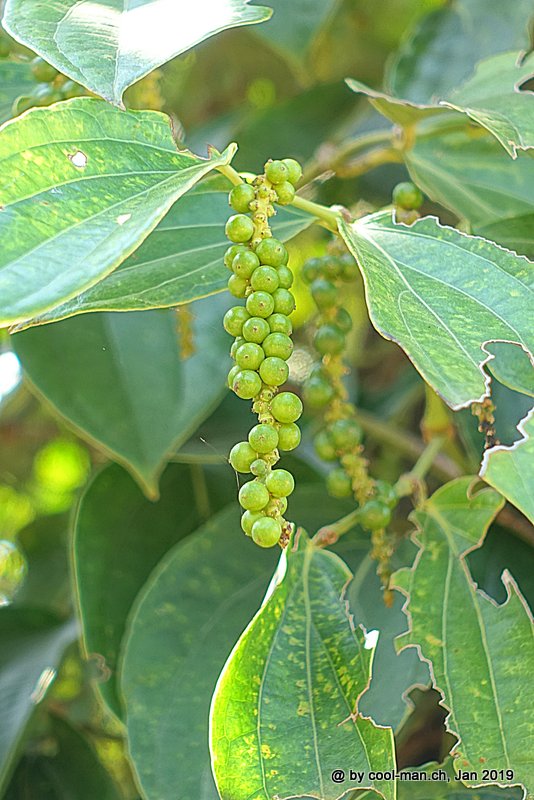
The most common pepper is black, but depending on the time of harvest and further treatment, peppercorns are produced in different colors.
Black pepper is produced from the unripe green to just before maturity standing yellow-orange peppercorns, which become wrinkly and black when dried. This pepper has the most intense pepper taste.
Green pepper is obtained from unripe, early harvested fruits. After harvesting, it is preserved in salt water or vinegar or quickly dried at high temperatures. It therefore retains its original green color. When dried, it keeps for about a year. This pepper is the least spicy.
White pepper is fully ripe pepper whose skin has been removed. The ripe red peppercorns are soaked in running water for eight to fourteen days so that the skin peels off. Then they are peeled and dried in the sun.
Red pepper consists of perfectly ripe, unpeeled peppercorns. It is the rarest because it is not easy to harvest the peppercorns by hand at the right time and at full maturity.
After the tour we were able to taste and buy the different pepper products. I was pleasantly surprised because this pepper really has a much more intense taste than regular pepper. Although I almost never buy products on the journey due to weight restrictions on my long trips, I couldn’t resist this pepper.
We had to wait for our return. I joined the drivers of other visitors who were watching a cockfight live on TV in one room. The cock on the left was a real professional who took his opponent in a headlock.

Bokor National Park
The next day we visited by minibus the 40 km distant Bokor National Park. It covers an over 1,000 meters high hill, which offers a great view over the coast and the sea.
We did not take the ‘Red Bulls Tour’ which was done on a motorcycle.

The colonial power France built a luxury resort, the Bokor Palace Hotel, a church, a post office and other residential properties on the Bokor hill in the 1920s to escape the heat, humidity and all the inconveniences of Phnom Penh. The buildings were abandoned in the late 1940s with the outbreak of the 1st Indochina War.
We first visited the overgrown Black Palace, built in 1936 as the residence of King Sihanouk.
Lok Yeay Mao Monument
Opposite the road, the statue of the mythical heroine Lok Yeay Mao, built in 2012, can be seen from far away. She is the patron saint of travelers and hunters. Although the French had destroyed the temple in honor of Lok Yeay Mao in 1900, the faith in this woman remained. Shortly after the new road to Bokor Hill was completed in 2011, the 29 meter high statue was inaugurated.

Sampov Pram Pagoda Temple
The Sampov Pram Pagoda Temple, built in 1924, stands at the highest point of the Bokor Hill with a view over the Cambodian coast.

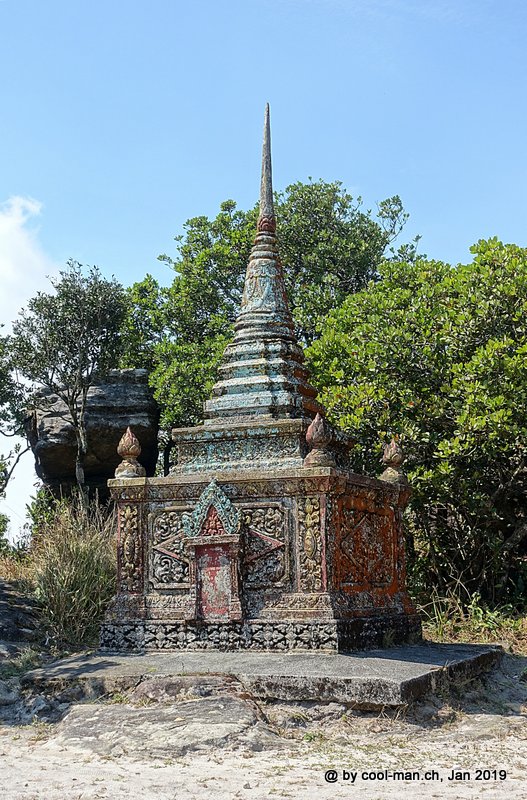
As in Wat Phnom Temple in Phnom Penh, the goddess of the earth squeezes water out of her hair to wash away Mara, the goddess of evil, with the flood of water.

The storage room of the temple
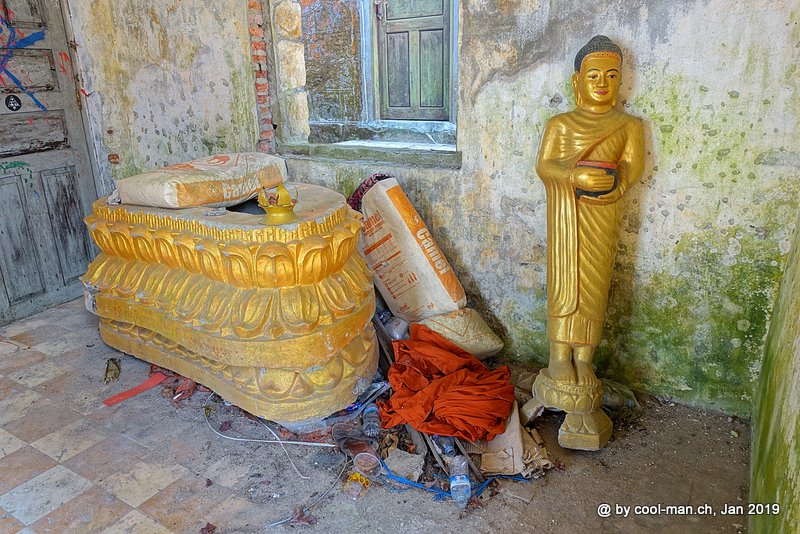
Thansur Bokor Highland Resort
The whole Bokor Hill National Park was leased by the Cambodian government to the company Sokimex for 99 years. In addition to the newly built road, there is already a hotel and casino complex and the luxury hotel Thansur Bokor Highland Resort completed. The hotel seemed hardly occupied.
The dining room of the luxury hotel Thansur Bokor Highland Resort
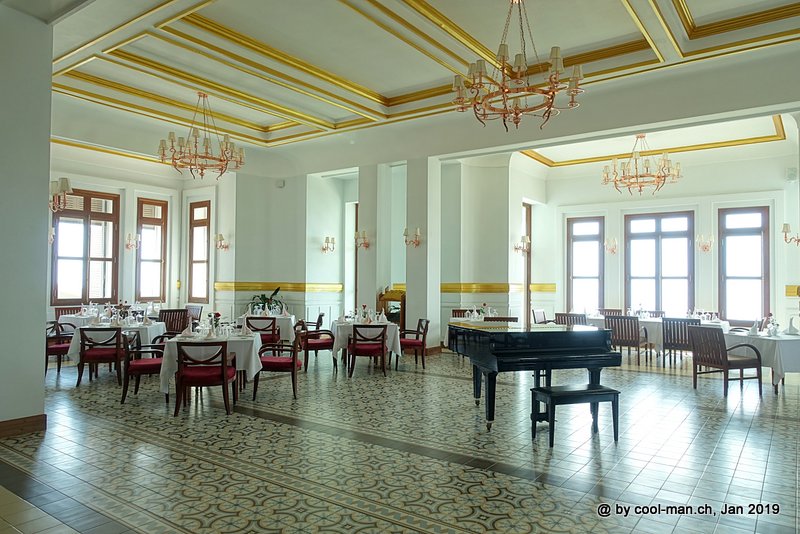
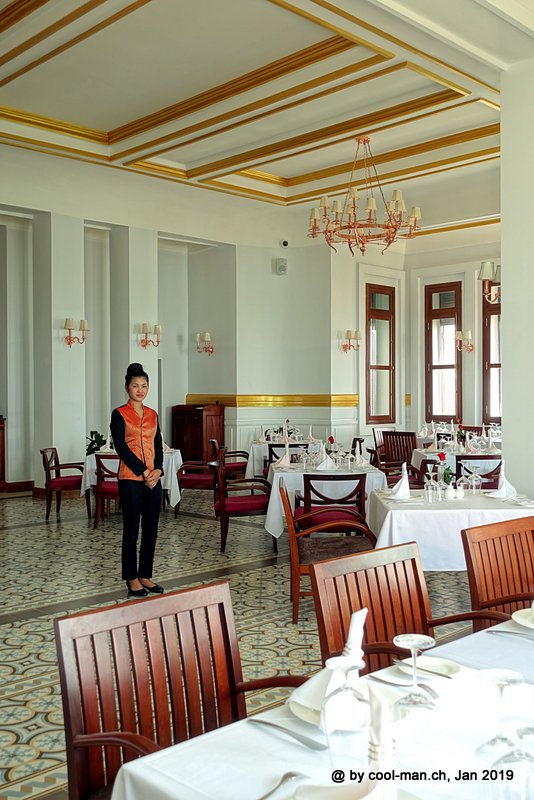
The Catholic Church built under French rule
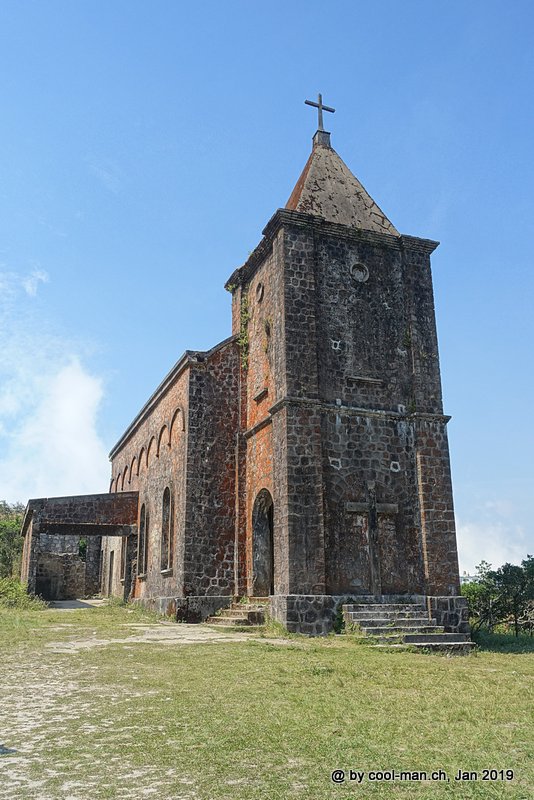
Only a few statues of saints and crosses can be found in the church. The statue on the right in the corner is brand new and still sealed in plastic.
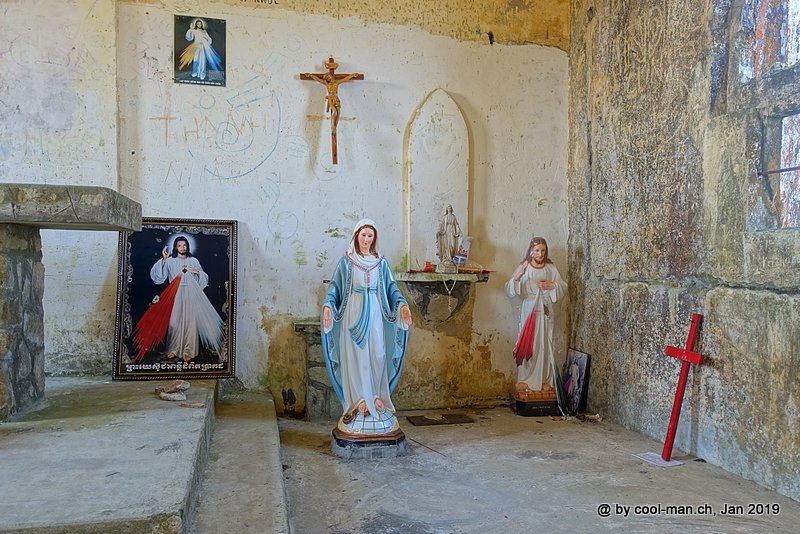
The tour also included a sunset boat trip on the Preaek Tuek Chhu River leading to a spot with a few fireflies.
After a few days in Kampot I wanted to discover the Cambodian beaches. The Otres Beeach near the city of Sihanoukville had been recommended to me. But the times change quickly at this once quiet beach, because the Chinese are building a huge casino complex right next door and offer small resort owners on the beach tempting amounts, so that they can also build over the land directly on the beach with hotels for Chinese guests. Construction noise, waste and polluted water deter the western tourists, so that the Cambodian small hotel owners can no longer survive and often have to sell. Therefore the Otres beach was not an option.
The Sihanoukville offshore islands Koh Rong and above all Koh Rong Samloem have so far been spared these developments. But I had to rule out a visit to these islands because of the sand flies. Sand flies are very small flying bloodsucking insects, which cannot be harmed by mosquito spray and whose stings itch for up to a week. I seem to be particularly allergic to these critters. For this reason the Rabbit Island off the Cambodian coast was no destination for me either.
I therefore decided to visit the small town of Kep, 30 km from Kampot, alone for a few days, as my colleague wanted to stay further in Kampot.
Kep
Kep was founded by the French in 1908 and was once Kep-sur-Mer, the Saint-Tropez of Indochina, where the Cambodian royal family enjoyed themselves. A few years ago many dilapidated villas were still visible, which are now being renovated and rebuilt. The beach of Kep, extended with sand from Otres Beach near Sihanoukville, is small. All the more famous is the town for its crabs, which are sold at the crab market and can be found on the menu of every restaurant.
Kep National Park
Another tourist attraction is the Kep National Park, a forest above the town that invites you to take a walk. I found the ‘Sunset Rock’ via small paths and thanks to the map on my mobile phone, from where I could enjoy this view of Kep.
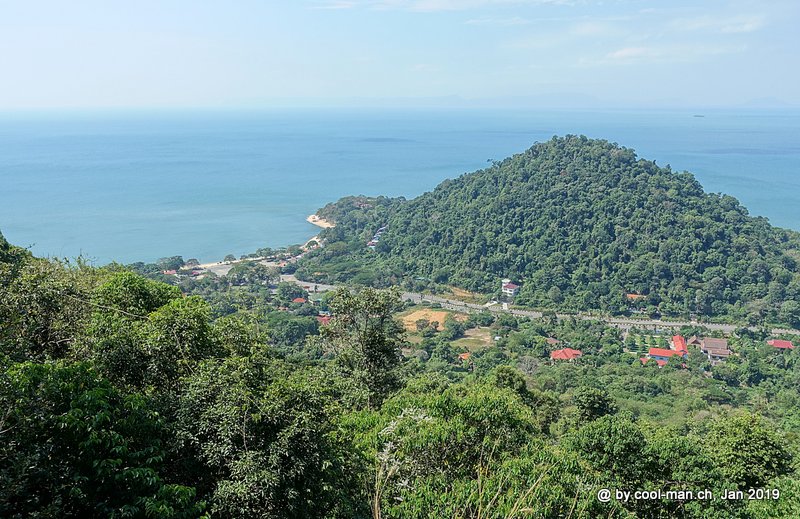
Samathi Pagoda
Another highlight is the Buddhist temple Samathi Pagoda above Kep.
There are impressive statues around the temple Samathi Pagoda.

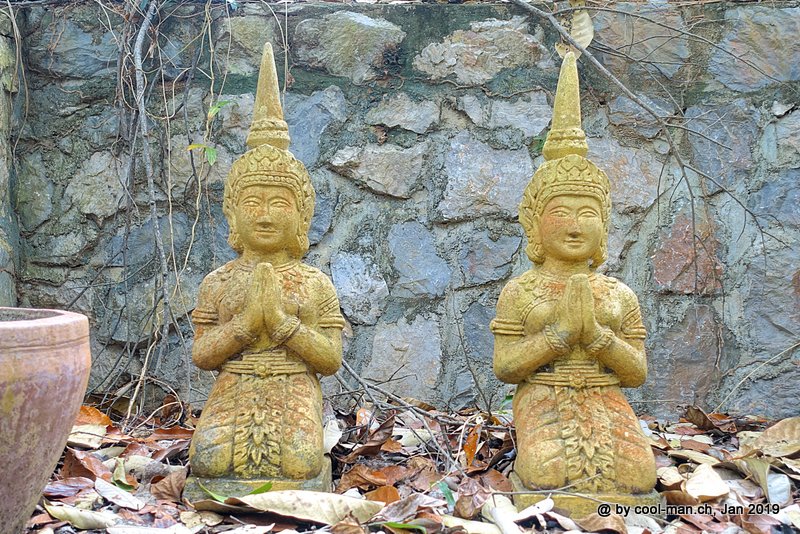
At sunset, the restaurants near the crab market serve crab meals.
‘The Strand’ Resort
‘The Strand’ Resort is supposed to have the best restaurant in Kep. Of course I wanted to get to know this place and reserved a table.
When I arrived, I was surprised that they had prepared a table for my ‘dinner for one’ right by the sea. In fact, the courses served were of excellent quality. Only the ‘Oskar’ in Phnom Penh could keep up.
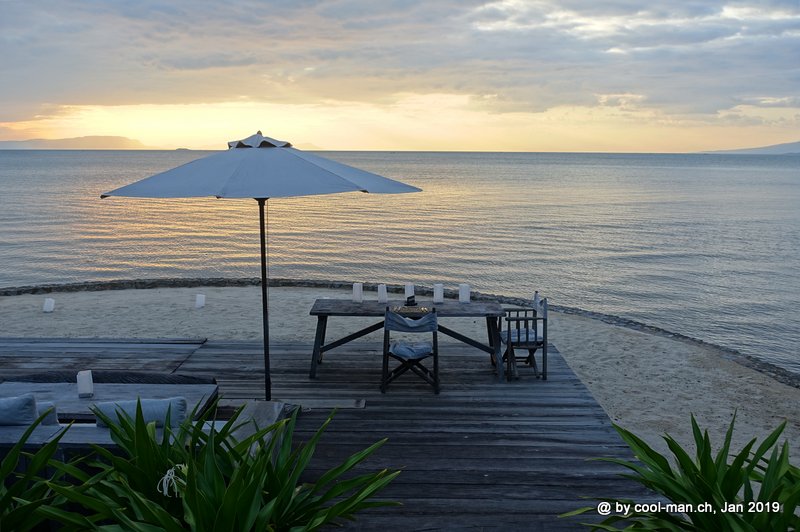
Before my dinner at ‘The Strand’ I enjoyed an aperitif at the neighboring ‘Sailing Club’ with a wonderful sunset atmosphere.
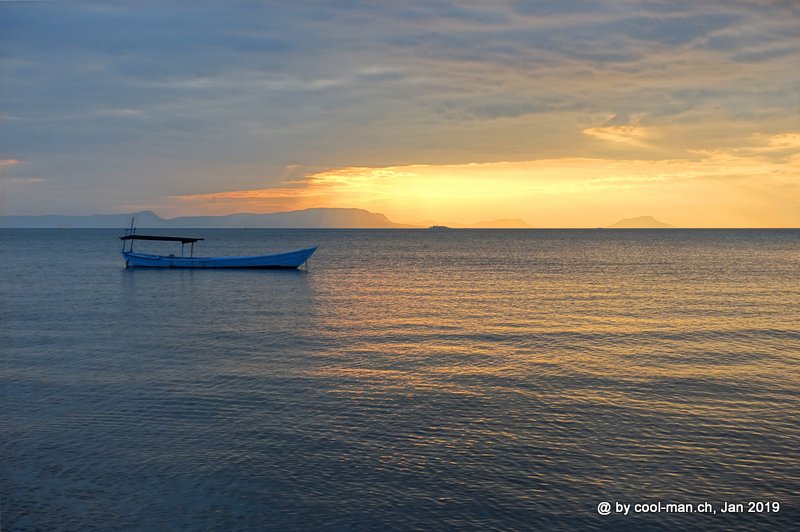
In Kep I noticed the many oversized new government buildings. I saw the Ministry of Education, Youth and Sports, the Ministry of Economy and Finance, the Ministry of Public Works and Transport, the Ministry of Land Management, Town Planning and Construction, the Ministry of the Environment, the Ministry of Agriculture, Forestry and Fisheries, the Ministry of Trade and the Military Command each in a new building for the province of 40,000 inhabitants. Despite the country’s poverty, the government appears to be doing well.
I lived in a guesthouse owned by a Swiss, which he runs with his Cambodian family. He was just complaining about the police, who suggested that he hire a night guard despite his five dogs. They also recommended a company that offers guards. He estimated that half of all businesses run by foreigners were in the red. After all his experiences he would not open a guesthouse any more.
I met my colleague again in Kampot. We enjoyed the gastronomic scene there for a few more days before we traveled back to Phnom Penh. On the last evening I invited my colleague to the restaurant ‘Oskar’, where we dined very well.
According to my plan I wanted to travel for one month to less touristy islands in the south of Thailand. But because of the upcoming Chinese New Year, the best accommodations there were very well booked or even fully booked. I like to travel spontaneously without booking everything in advance, so I brought the Maldives trip forward. From Phnom Penh I flew via Bangkok to Male, the capital of the Maldives.
This text is an automatic English translation from the German original by deepl.com